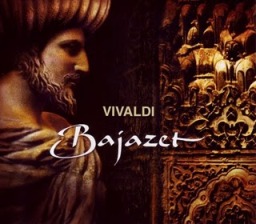Antonio Vivaldi – Bajazet (2005)
Antonio Vivaldi – Bajazet (2005)

Disc 1
1. Sinfonia : Allegro
2. Sinfonia : Andante Molto
3. Sinfonia : Allegro
4. Acte 1, Scène 1 : Prence Lo So, Vi Devo
5. Acte 1, Scène 1 : Del Destin Non Dee Lagnarsi
6. Acte 1, Scène 2 : Non Si Perda Di Vista
7. Acte 1, Scène 2 : Nasce Rosa Lusinghiera
8. Acte 1, Scène 3 : Principe, Or Ora I Greci
9. Acte 1, Scène 3 : In Si Torbida Procella
10. Acte 1, Scène 4 : Il Tartaro Ama Asteria
11. Acte 1, Scène 4 : Quel Ciglio Vezzosetto
12. Acte 1, Scène 5-6 : Or Si, Fiero Destino
13. Acte 1, Scène 5-6 : Vedeste Mai Sul Prato
14. Acte 1, Scène 7-8 : Non Ascolto Piu Nulla
15. Acte 1, Scène 7-8 : Amare Un'Alma Ingrata
16. Acte 1, Scène 9 : Cosi La Sposa Il Tamerlano Accoglie?
17. Acte 1, Scène 9 : Qual Guerriero In Campo Armato
18. Acte 1, Scène 10 : E Bella Irene
19. Acte 1, Scène 10 : Non Ho Nel Sen Costanza
20. Acte 2, Scène 1 : Amico, Tengo Un Testimon Fedele
21. Acte 2, Scène 2 : Sarete Or Ostinato
22. Acte 2, Scène 2 : Anche Il Mar Par Che Sommerga
23. Acte 2, Scène 3 : Gloria, Sdegno Ed Amore
24. Acte 2, Scène 3 : Stringi Le Mie Catene
Disc 2
1. Acte 2, Scène 4 : Ah, Disperato Andronico!
2. Acte 2, Scène 4 : La Sorte Mia Spietata
3. Acte 2, Scène 5 : Signor, Vergine Illustre
4. Acte 2, Scène 5 : Cruda Sorte, Avverso Fato!
5. Acte 2, Scène 6 : Senti, Chiunque Tu Sia
6. Acte 2, Scène 6 : La Cervetta Timidetta
7. Acte 2, Scène 7 : Gran Cose Espone Asteria
8. Acte 2, Scène 7 : Sposa, Son Disprezzata
9. Acte 2, Scène 8 : Dov'E Mia Figlia, Andronico?
10. Acte 2, Scène 8 : Dov'E La Figlia?
11. Acte 2, Scène 9 : Asteria, Siamo Al Soglio
12. Acte 2, Scène 9 : Si Crudel! Questo E L'Amore
13. Acte 3, Scène 1 : Figlia, Siam Rei
14. Acte 3, Scène 1 : Veder Parmi, Or Che Nel Fondo
15. Acte 3, Scène 2-3 : Andronico, Il Mio Amore
16. Acte 3, Scène 2-3 : Barbaro Traditor
17. Acte 3, Scène 4 : Lascero Di Regnare
18. Acte 3, Scène 4 : Spesso Tra Vaghe Rose
19. Acte 3, Scène 5-7 : Eccoti, Bajazette
20. Acte 3, Scène 5-7 : Verro Crudel, Spietato
21. Acte 3, Scène 8 : Signor, Fra Tante Cure
22. Acte 3, Scène 8 : Son Tortorella
23. Acte 3, Scène 9 : Signore, Bajazette
24. Acte 3, Scène 10 : E Morto, Si, Tiranno
25. Acte 3, Scène 10 : Svena, Uccidi, Abbatti, Atterra
26. Acte 3, Scène Finale : Deh, Tu Cauto La Segui
27. Acte 3, Scène Finale : Coronata Di Gigli E Rose
BAJAZET: Ildebrando D'Arcangelo bass-baritone
TAMERLANO: David Daniels countertenor
ASTERIA: Marijana Mijanovic mezzo-soprano
ANDRONICO: Elina Garanca mezzo-soprano
IRENE: Vivica Genaux mezzo-soprano
IDASPE: Patrizia Ciofi soprano
Europa Galante
Fabio Biondi - director
Vivaldi's pasticcio opera Il Bajazet was composed for the carnival season of Venice in 1735. It includes many pieces from earlier works of Vivaldi's, including arias and a quartet from his opera Farnace, but he also borrowed musical numbers from the works of Johann Adolph Hasse, Geminiano Giacomelli, and others to use in the score. Vivaldi is known to us today primarily through his instrumental music, partly because he began composing operas rather late in life. However, he applied the same techniques to his operatic writing as he did to his concerti and other instrumental forms, and his operas enjoyed a good deal of success. Although comparatively conservative in his dramatic approach, he nevertheless shows imagination in presenting the various emotions and situations of his characters. By the year 1735, serious opera had settled into a standard structure in which simple recitative helped the action of the drama unfold, and large scale da capo arias, which resembled vocal concertos, served to discharge the dramatic and emotional tensions of a scene and showcase virtuoso star singers. Another important musical form at the composer's disposal was the accompanied recitative, used for scenes of extreme drama and passion, and often setting scenes of solo monologue. As Bajazet witnesses his daughter promise to marry his archenemy Tamerlano, his violent emotions are given expression in a flexible texture of declamation and arioso singing, supported by an expressive and dramatic orchestra. Later in the opera, when Asteria thinks of her own hatred for Tamerlano, and grieves over her father's death, her solo is also preceded by a dramatic scena of accompanied recitative. This leads right into her aria "Svena uccidi," which expresses her violent hatred in an energetic triple time presto, followed by a melancholic duple andante, with a simple solo line and a pulsating accompaniment, as she grieves for her dead father. Throughout the initial recitative and aria, the changing emotions and thoughts of the protagonist are dramatized by the changing figures in the orchestra, changing timbres, and changing tempi. ---Rita Laurance, Rovi
download: uploaded yandex 4shared mediafire solidfiles mega zalivalka filecloudio anonfiles oboom
Last Updated (Friday, 20 June 2014 11:00)








